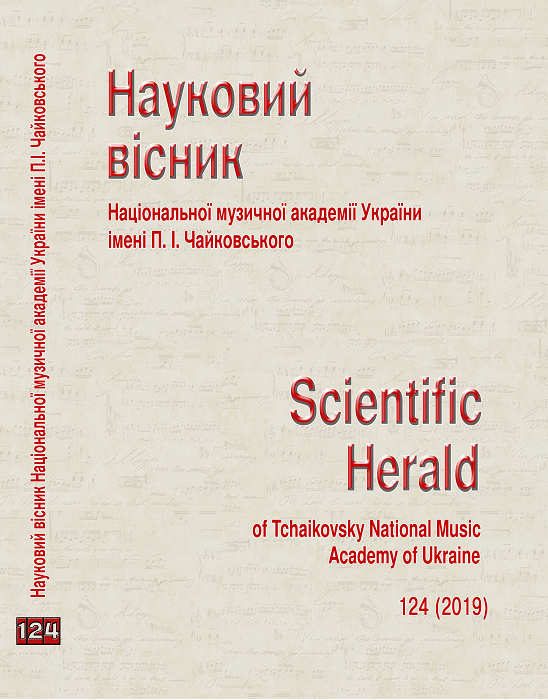Rethinking Stravinsky historically and theoretically
DOI:
https://doi.org/10.31318/2522-4190.2019.124.165417Keywords:
the work of Igor Stravinsky, Spring (Cloister Song), The Rite of Spring, morpheme, morph, polymorphismAbstract
A new perspective is proposed on the evolution of musical culture in the 20th century. Within this process, the central position occupied by the work of the St. Petersburg Classic School – Stravinsky, Prokofiev, and Shostakovich – is highlighted. For a more profound understanding of Stravinsky’s music, the categorical pair of the morpheme and morph is introduced for use in musical analysis. The morphic realization of the morphemes of the environment, motion, space, and dissonance, and the Janus morpheme, is traced in the text of the romance Spring (Cloister Song) and in the Introduction to the ballet The Rite of Spring. An essential conclusion is drawn regarding the polymorphic nature of the musical fabric in the Russian master’s works.
Downloads
References
Asaf’ev, B. (1977). Book of Stravinsky [Kniga o Stravinskom]. 2nd ed. Leningrad: Muzyka, 279 p. [in Russian].
Boulez, P. (1991). Stocktaking from an Apprenticeship. Oxford: Clarendon Press, 316 p. [in English].
Cantoni, A. (2014). The Language of Stravinsky. Hildesheim·Zürich·New York: Georg Olms Verlag, 500 р. [in English].
Glivinskij, V. (1995). Later works of I. F. Stravinsky. Study. [Pozdnee tvorchestvo I. F. Stravinskogo. Issledovanie]. Donetsk: Donechchyna, 191 p. [in Russian].
Glivinsky, V. & Fedoseyev, I. (2016). The St. Petersburg Classic School: myth or reality? European Journal of Arts, vol.1, pp. 14-20. [in English].
Glivinsky, V. & Fedoseyev, I. (2016). The Creative Archetypes of the Classic Composers’ Schools. European Journal of Arts, vol. 3, pp. 24-31. [in English].
Glivinsky, V. (2016). “A fly in a borsch” or a story about how Allen Fort quarreled with Richard Taruskin [«Muha v borshhe» ili Rasskaz o tom, kak possorilis’ Allen Fort s Richardom Taruskinym]. Musicology [Muzykovedenie], vol.10, pр. 44-51. [in Russian].
Golovinskij, G. (1981). Composer and folklore. From the experience of masters XIX – XX centuries. Essays. [Kompozitor i fol’klor. Iz opyta masterov XIX–XX vekov. Ocherki]. Мoscow: Muzyka, 279 p. [in Russian].
Ivashkin, A. (1995). Shostakovich and Schnittke. To the problem of the big symphony [Shostakovich i Shnitke. K probleme bol’shoj simfonii]. Academy of Music [Muzykal’naja akademija], vol. 1, pp. 1- 8. [in Russian].
Linguistic Encyclopedic Dictionary [Lingvisticheskij jenciklopedicheskij slovar’] (1990). Morph [Morf]. Мoscow: Sovetskaja Jenciklopedija. Available at: http://tapemark.narod.ru/les/311b.html (Accessed 5 Jan. 2019). [in Russian].
Linguistic Encyclopedic Dictionary [Lingvisticheskij jenciklopedicheskij slovar’] (1990). Morpheme [Morfema]. Мoscow: Sovetskaja Jenciklopedija. Available at: http://tapemark.narod.ru/les/312a.html (Accessed 5 Jan. 2019). [in Russian].
Messian, O. (2011). Analysis of the “Spring sacred” Stravinsky. Rhythmic characters [Analiz «Vesny svjashhennoj» Stravinskogo. Ritmicheskie personazhi]. In: V. Smirnov, ed., Ustyluh – Hollywood: about Stravinsky and his work: cb. articles [Ustilug – Hollywood: o Stravinskom i ego tvorchestve]. St. Petersburg: Kompozitor, pp. 137–210. [in Russian].
Morton, L. (1979). Footnotes to Stravinsky Studies: Le sacre du printemps. Tempo, vol. 128, pp. 9-16. [in English].
Neff, S. (2017). How Not to Hear Le sacre du printemps? Schoenberg’s Theories, Leibowitz’s Recording. In: S. Neff, M. Carr, G. Horlacher, and J. Reef ed., The Rite of Spring at 100. Indiana: Indiana University Press, pp. 304-330. [in English].
Ruch’evskaja, E. (2011). On the relationship between words and melodies in Russian chamber-vocal music of the beginning of the twentieth century [O sootnoshenii slova i melodii v russkoj kamerno-vokal’noj muzyke nachala XX veka]. In: V. Gorjachih ed., Ruchevskaya E. A. Works from different years: In 2 volumes. T. II: About vocal music [E. A. Ruch’evskaja. Raboty raznyh let: V 2 t. T. II. O vokal’noj muzyke]. St. Petersburg: Kompozitor, pp. 43– 90. [in Russian].
Rufer, J. (1959). The Works of Arnold Schoenberg. London: Faber and Faber, 214 p. [in English].
Schaeffner, A. (1931). Stravinsky [Strawinsky]. Paris: Éditions Rieder, 127 p., LX ill. [in French].
Schoenberg, A. (1950). Style and Idea. New York: Philosophical Library, 224 p. [in English].
Skrebkov, S. (2016). Artistic principles of musical styles [Hudozhestvennye principy muzykal’nyh stilej]. 2nd ed. St. Petersburg: Lan’, Planeta muzyki, 448 p. [in Russian].
Smirnov, V. (1970). The creative formation of I. F. Stravinsky [Tvorcheskoe formirovanie I. F. Stravinskogo]. St. Petersburg: Muzyka, 152 p. [in Russian].
Stravinskij, I. (1971). Dialogues: Memories. Reflections. Comments [Dialogi: Vospominanija. Razmyshlenija. Kommentarii]. Leningrad: Muzyka, 414 p. [in Russian].
Stravinskij, I. (2000). Correspondence with Russian correspondents. Materials for the biography. Volume II: 1913–1922 [Perepiska s russkimi korrespondentami. Materialy k biografii. Tom II: 1913–1922]. Мoscow: Kompozitor, 799 p. [in Russian].
Stravinsky I., Craft R. (2002). Memories and Cоmmentaries. London: Faber and Faber, 311 p. [in English].
Vershinina, I. (1967). Stravinsky Early Ballets [Rannie balety Stravinskogo]. Мoscow: Nauka, 223 p. [in Russian].
Zaderatskij, V. (2007). Polyphonic thinking I. Stravinsky [Polifonicheskoe myshlenie I. Stravinskogo]. 2nd ed. Мoscow: Kompozitor, 277 p. [in Russian].
Downloads
Published
How to Cite
Issue
Section
License
Our journal abides by the CREATIVE COMMONS copyright rights and permissions for open access journals.
Authors, who are published in this journal, agree to the following conditions:
The authors reserve the right to authorship of the work and pass the first publication right of this work to the journal under the terms of a Creative Commons Attribution License, which allows others to freely distribute the published research with the obligatory reference to the authors of the original work and the first publication of the work in this journal.
The authors have the right to conclude separate supplement agreements that relate to non-exclusive work distribution in the form in which it has been published by the journal (for example, to upload the work to the online storage of the journal or publish it as part of a monograph), provided that the reference to the first publication of the work in this journal is included.




